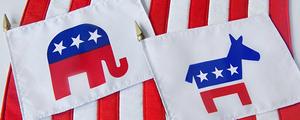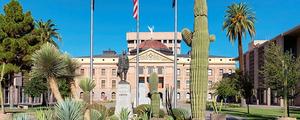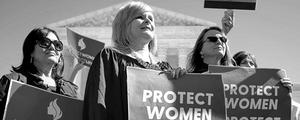Story Highlights
- 34% in the U.S. identify as conservative, down from 40% in February
- Conservatism slides most among upper-income and middle-aged adults
- Adults under 35 more likely to identify as liberal than conservative
WASHINGTON, D.C. -- Americans' ideological bent has shifted in the first half of 2020 with fewer people self-identifying as politically conservative in May and June than at the start of the year. There has been a corresponding increase in self-described liberals while the percentage moderate has been fairly steady.

Line graph. Monthly trend from January to June 2020 in Americans' self-identified political ideology. Percentage conservative fell from 40% in January/February to 34% by May/June. Percentage liberal increased from 22% to 26% over the same period while percentage moderate was relatively steady near 36%.
In January and February, an average of 40% of Americans identified as politically conservative. This was up from an average of 37% in 2019 and was tied for the highest rate of conservatism Gallup had recorded in the past six years. This coincided with President Donald Trump being acquitted of impeachment charges. It also came amidst strongly positive economic signals in the form of near-record-low unemployment and the Dow Jones Industrial Average reaching record highs.
Nevertheless, the percentage of Americans identifying as conservative reverted to an average 37% in March and April as the coronavirus pandemic emerged. It fell further to 34% in May and June as the pandemic has worn on, Trump's job approval rating has tumbled, and the racial justice movement emerged as a national focus following the death of George Floyd.
Meanwhile, the percentages identifying as liberal increased from an average of 22% in January/February to 26% in May/June.
Gallup measures Americans' ideology by asking respondents to describe their overall political views as either very conservative, conservative, moderate, liberal or very liberal.
The recent shifts in how Americans conceive of their political views mirror the decline in Republican Party identification -- and the corresponding increase in Democratic Party identification -- in the first half of 2020.
Conservatism Dips Most Among Middle-Aged, Upper-Income Adults
The decline in self-identified conservatism in 2020 has been seen about evenly among men and women, and among all political party groups.
However, it was more pronounced among adults in upper-income households as well as among middle-aged adults (aged 35 to 54) than their counterparts.
The conservative falloff has also been stronger among White and Hispanic Americans than Black Americans. Relatively few Black Americans (25%) identified as conservative in January/February, and thus there may have been less opportunity for the rate to decline.
| Jan/Feb | Mar/Apr | May/Jun | Change since Jan/Feb |
|||||||||||||||||||||||||||||||||||||||||||||||||||||||||||||||||||||||||||||||||||||||||||||||||
|---|---|---|---|---|---|---|---|---|---|---|---|---|---|---|---|---|---|---|---|---|---|---|---|---|---|---|---|---|---|---|---|---|---|---|---|---|---|---|---|---|---|---|---|---|---|---|---|---|---|---|---|---|---|---|---|---|---|---|---|---|---|---|---|---|---|---|---|---|---|---|---|---|---|---|---|---|---|---|---|---|---|---|---|---|---|---|---|---|---|---|---|---|---|---|---|---|---|---|---|---|
| % | % | % | Pct. pts. | |||||||||||||||||||||||||||||||||||||||||||||||||||||||||||||||||||||||||||||||||||||||||||||||||
| Gender | ||||||||||||||||||||||||||||||||||||||||||||||||||||||||||||||||||||||||||||||||||||||||||||||||||||
| Men | 44 | 41 | 38 | -6 | ||||||||||||||||||||||||||||||||||||||||||||||||||||||||||||||||||||||||||||||||||||||||||||||||
| Women | 36 | 33 | 31 | -5 | ||||||||||||||||||||||||||||||||||||||||||||||||||||||||||||||||||||||||||||||||||||||||||||||||
| Age | ||||||||||||||||||||||||||||||||||||||||||||||||||||||||||||||||||||||||||||||||||||||||||||||||||||
| 18 to 34 | 28 | 25 | 25 | -3 | ||||||||||||||||||||||||||||||||||||||||||||||||||||||||||||||||||||||||||||||||||||||||||||||||
| 35 to 54 | 44 | 37 | 34 | -10 | ||||||||||||||||||||||||||||||||||||||||||||||||||||||||||||||||||||||||||||||||||||||||||||||||
| 55 and older | 47 | 45 | 41 | -6 | ||||||||||||||||||||||||||||||||||||||||||||||||||||||||||||||||||||||||||||||||||||||||||||||||
| Education | ||||||||||||||||||||||||||||||||||||||||||||||||||||||||||||||||||||||||||||||||||||||||||||||||||||
| College graduate | 31 | 28 | 25 | -6 | ||||||||||||||||||||||||||||||||||||||||||||||||||||||||||||||||||||||||||||||||||||||||||||||||
| Not college graduate | 46 | 41 | 40 | -6 | ||||||||||||||||||||||||||||||||||||||||||||||||||||||||||||||||||||||||||||||||||||||||||||||||
| Household income | ||||||||||||||||||||||||||||||||||||||||||||||||||||||||||||||||||||||||||||||||||||||||||||||||||||
| Less than $40,000 | 41 | 36 | 37 | -4 | ||||||||||||||||||||||||||||||||||||||||||||||||||||||||||||||||||||||||||||||||||||||||||||||||
| $40,000 to $99,000 | 42 | 39 | 38 | -4 | ||||||||||||||||||||||||||||||||||||||||||||||||||||||||||||||||||||||||||||||||||||||||||||||||
| $100,000+ | 40 | 35 | 29 | -11 | ||||||||||||||||||||||||||||||||||||||||||||||||||||||||||||||||||||||||||||||||||||||||||||||||
| Race/Ethnicity | ||||||||||||||||||||||||||||||||||||||||||||||||||||||||||||||||||||||||||||||||||||||||||||||||||||
| Non-Hispanic White Americans | 45 | 42 | 38 | -7 | ||||||||||||||||||||||||||||||||||||||||||||||||||||||||||||||||||||||||||||||||||||||||||||||||
| Non-Hispanic Black Americans | 25 | 27 | 22 | -3 | ||||||||||||||||||||||||||||||||||||||||||||||||||||||||||||||||||||||||||||||||||||||||||||||||
| Hispanic Americans | 37 | 29 | 31 | -6 | ||||||||||||||||||||||||||||||||||||||||||||||||||||||||||||||||||||||||||||||||||||||||||||||||
| Type of community | ||||||||||||||||||||||||||||||||||||||||||||||||||||||||||||||||||||||||||||||||||||||||||||||||||||
| Big/Small city | 36 | 32 | 33 | -3 | ||||||||||||||||||||||||||||||||||||||||||||||||||||||||||||||||||||||||||||||||||||||||||||||||
| Suburb | 36 | 37 | 28 | -8 | ||||||||||||||||||||||||||||||||||||||||||||||||||||||||||||||||||||||||||||||||||||||||||||||||
| Town/Rural area | 50 | 43 | 43 | -7 | ||||||||||||||||||||||||||||||||||||||||||||||||||||||||||||||||||||||||||||||||||||||||||||||||
| Party ID | ||||||||||||||||||||||||||||||||||||||||||||||||||||||||||||||||||||||||||||||||||||||||||||||||||||
| Republicans | 77 | 75 | 73 | -4 | ||||||||||||||||||||||||||||||||||||||||||||||||||||||||||||||||||||||||||||||||||||||||||||||||
| Independents | 32 | 28 | 28 | -4 | ||||||||||||||||||||||||||||||||||||||||||||||||||||||||||||||||||||||||||||||||||||||||||||||||
| Democrats | 14 | 13 | 11 | -3 | ||||||||||||||||||||||||||||||||||||||||||||||||||||||||||||||||||||||||||||||||||||||||||||||||
| Based on combined data from Gallup's nationally representative telephone polls conducted in each time period | ||||||||||||||||||||||||||||||||||||||||||||||||||||||||||||||||||||||||||||||||||||||||||||||||||||
| Gallup, 2020 | ||||||||||||||||||||||||||||||||||||||||||||||||||||||||||||||||||||||||||||||||||||||||||||||||||||
Handful of Groups Are More Liberal Than Conservative
More broadly, in recent months, most subgroups of Americans remain more likely to call themselves conservative than liberal; however, young adults, college graduates, Black Americans and Democrats are the exceptions with more identifying as liberal than conservative. Still, aside from Democrats, all of these groups are most likely to identify as politically moderate.
| Conservative | Moderate | Liberal | Net conservative |
|||||||||||||||||||||||||||||||||||||||||||||||||||||||||||||||||||||||||||||||||||||||||||||||||
|---|---|---|---|---|---|---|---|---|---|---|---|---|---|---|---|---|---|---|---|---|---|---|---|---|---|---|---|---|---|---|---|---|---|---|---|---|---|---|---|---|---|---|---|---|---|---|---|---|---|---|---|---|---|---|---|---|---|---|---|---|---|---|---|---|---|---|---|---|---|---|---|---|---|---|---|---|---|---|---|---|---|---|---|---|---|---|---|---|---|---|---|---|---|---|---|---|---|---|---|---|
| % | % | % | Pct. pts. | |||||||||||||||||||||||||||||||||||||||||||||||||||||||||||||||||||||||||||||||||||||||||||||||||
| Gender | ||||||||||||||||||||||||||||||||||||||||||||||||||||||||||||||||||||||||||||||||||||||||||||||||||||
| Men | 38 | 36 | 22 | +16 | ||||||||||||||||||||||||||||||||||||||||||||||||||||||||||||||||||||||||||||||||||||||||||||||||
| Women | 31 | 35 | 30 | +1 | ||||||||||||||||||||||||||||||||||||||||||||||||||||||||||||||||||||||||||||||||||||||||||||||||
| Age | ||||||||||||||||||||||||||||||||||||||||||||||||||||||||||||||||||||||||||||||||||||||||||||||||||||
| 18 to 34 | 25 | 36 | 35 | -10 | ||||||||||||||||||||||||||||||||||||||||||||||||||||||||||||||||||||||||||||||||||||||||||||||||
| 35 tp 54 | 34 | 38 | 25 | +9 | ||||||||||||||||||||||||||||||||||||||||||||||||||||||||||||||||||||||||||||||||||||||||||||||||
| 55 and older | 41 | 34 | 21 | +20 | ||||||||||||||||||||||||||||||||||||||||||||||||||||||||||||||||||||||||||||||||||||||||||||||||
| Education | ||||||||||||||||||||||||||||||||||||||||||||||||||||||||||||||||||||||||||||||||||||||||||||||||||||
| College graduate | 25 | 40 | 34 | -9 | ||||||||||||||||||||||||||||||||||||||||||||||||||||||||||||||||||||||||||||||||||||||||||||||||
| Not college graduate | 40 | 34 | 22 | +18 | ||||||||||||||||||||||||||||||||||||||||||||||||||||||||||||||||||||||||||||||||||||||||||||||||
| Household income | ||||||||||||||||||||||||||||||||||||||||||||||||||||||||||||||||||||||||||||||||||||||||||||||||||||
| Less than $40,000 | 37 | 31 | 29 | +8 | ||||||||||||||||||||||||||||||||||||||||||||||||||||||||||||||||||||||||||||||||||||||||||||||||
| $40,000 to $99,999 | 38 | 36 | 25 | +13 | ||||||||||||||||||||||||||||||||||||||||||||||||||||||||||||||||||||||||||||||||||||||||||||||||
| $100,000 or more | 29 | 43 | 28 | +1 | ||||||||||||||||||||||||||||||||||||||||||||||||||||||||||||||||||||||||||||||||||||||||||||||||
| Race/Ethnicity | ||||||||||||||||||||||||||||||||||||||||||||||||||||||||||||||||||||||||||||||||||||||||||||||||||||
| Non-Hispanic White Americans | 38 | 34 | 25 | +13 | ||||||||||||||||||||||||||||||||||||||||||||||||||||||||||||||||||||||||||||||||||||||||||||||||
| Non-Hispanic Black Americans | 22 | 47 | 28 | -6 | ||||||||||||||||||||||||||||||||||||||||||||||||||||||||||||||||||||||||||||||||||||||||||||||||
| Hispanic Americans | 31 | 35 | 30 | +1 | ||||||||||||||||||||||||||||||||||||||||||||||||||||||||||||||||||||||||||||||||||||||||||||||||
| Type of community | ||||||||||||||||||||||||||||||||||||||||||||||||||||||||||||||||||||||||||||||||||||||||||||||||||||
| Big/Small city | 33 | 36 | 28 | +5 | ||||||||||||||||||||||||||||||||||||||||||||||||||||||||||||||||||||||||||||||||||||||||||||||||
| Suburb | 28 | 40 | 31 | -3 | ||||||||||||||||||||||||||||||||||||||||||||||||||||||||||||||||||||||||||||||||||||||||||||||||
| Town/Rural area | 43 | 33 | 22 | +21 | ||||||||||||||||||||||||||||||||||||||||||||||||||||||||||||||||||||||||||||||||||||||||||||||||
| Party ID | ||||||||||||||||||||||||||||||||||||||||||||||||||||||||||||||||||||||||||||||||||||||||||||||||||||
| Republicans | 73 | 20 | 5 | +68 | ||||||||||||||||||||||||||||||||||||||||||||||||||||||||||||||||||||||||||||||||||||||||||||||||
| Independents | 28 | 49 | 20 | +8 | ||||||||||||||||||||||||||||||||||||||||||||||||||||||||||||||||||||||||||||||||||||||||||||||||
| Democrats | 11 | 35 | 53 | -42 | ||||||||||||||||||||||||||||||||||||||||||||||||||||||||||||||||||||||||||||||||||||||||||||||||
| Based on combined data from Gallup's nationally representative telephone polls conducted in each time period | ||||||||||||||||||||||||||||||||||||||||||||||||||||||||||||||||||||||||||||||||||||||||||||||||||||
| Gallup, May-June 2020 | ||||||||||||||||||||||||||||||||||||||||||||||||||||||||||||||||||||||||||||||||||||||||||||||||||||
Bottom Line
As the United States has been transformed in 2020 from an economically prosperous country to one crippled by high unemployment and a sharp drop in GDP, Americans' perspective on politics has shifted. Part of this may stem from the economic challenges created by COVID-19, compelling large majorities of Republicans and Democrats alike to support the $2.2 trillion economic relief package passed by Congress in March.
The downward trajectory of President Trump's job approval rating, from a term high of 49% in February to 38% in June, is likely contributing to Americans' swing to the left. When Trump was prevailing over a strong economy and fighting off impeachment, conservative ideals may have had more appeal than today when his approval has fallen below 40% and his administration is struggling to contain the coronavirus.
America's recent focus on racial justice may also be a factor, with the country evaluating the equity of policies related to education, employment and policing, among other systems in the U.S.
What 2020 has shown is that political ideology is not a fixed construct, but one that can quickly shift with the political or economic winds. Americans grew more conservative in early 2020, but that dissipated by the middle of the year. That could affect how voters react to candidates running on the label in November. However, with more economic and political news ahead in the second half of the year, Americans' attachment to these labels could change yet again.
Learn more about how the Gallup Poll Social Series works.




